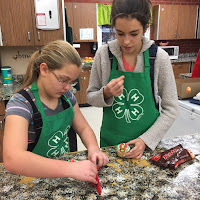 In anticipation of holiday treat platters inviting me to
sample sugary treats all week, I decided to build a small perimeter of
defense. I spent a bit of time last
Sunday evening chopping vegetables, lettuce, spinach and kale to assemble some
stacked salad combos to have ready for lunches all week. The hard-cooked eggs, garbanzo and black
beans were ready to add protein to the salads to sustain us through the
day. It had been more than year since I
spent a Sunday evening chopping and preparing salads for lunches. I think at one point, I had a salad for lunch
most every work day for six months. Isn’t
it strange how a disruption can throw you off of a good habit? A year or so ago, I was preparing the salads in wide-mouth quart jars. They looked so
pretty lined up in my refrigerator. Last
week, I put the salads in glass bowls instead.
Since I layer the salads, they are not as easy to eat from a jar. The salad fixings mix better while I’m eating
them from a bowl. I suppose I could use
plastic storage containers, but somehow the opaque plastic hides all the
inviting colors of the tomatoes, carrots, broccoli and beans. It seems if the food is prepared, easily
accessible and visible, it gets eaten. I
suppose knowing that simple fact is half the battle in daily health habits.
In anticipation of holiday treat platters inviting me to
sample sugary treats all week, I decided to build a small perimeter of
defense. I spent a bit of time last
Sunday evening chopping vegetables, lettuce, spinach and kale to assemble some
stacked salad combos to have ready for lunches all week. The hard-cooked eggs, garbanzo and black
beans were ready to add protein to the salads to sustain us through the
day. It had been more than year since I
spent a Sunday evening chopping and preparing salads for lunches. I think at one point, I had a salad for lunch
most every work day for six months. Isn’t
it strange how a disruption can throw you off of a good habit? A year or so ago, I was preparing the salads in wide-mouth quart jars. They looked so
pretty lined up in my refrigerator. Last
week, I put the salads in glass bowls instead.
Since I layer the salads, they are not as easy to eat from a jar. The salad fixings mix better while I’m eating
them from a bowl. I suppose I could use
plastic storage containers, but somehow the opaque plastic hides all the
inviting colors of the tomatoes, carrots, broccoli and beans. It seems if the food is prepared, easily
accessible and visible, it gets eaten. I
suppose knowing that simple fact is half the battle in daily health habits.
It is surprising how we unwittingly invite ourselves to make
food choices. It is no surprise that the
plate of chocolate fudge, peanut butter balls, caramels and cookies that is on
a glass platter sitting on the counter invites us to nibble and nosh, even when
we didn’t mean to do so. I may have just
gone to the kitchen for a glass of water, but if that goodies selection is
sitting there staring at me, it is unlikely that I will leave the kitchen with
just my glass of water. The good news is
that we can learn to make healthier foods just as inviting. Have you ever done a household food andnutrition assessment?
 Instead of coming home from the market and putting the
produce in the vegetable drawer, prepare it in ready-to-eat packaging. A bag of carrots can sit in the back of the
vegetable drawer for a long time without anyone being “invited” to eat them,
but, get them out and peel them, chop them and put them in a glass container in
the front of the refrigerator and they’ll invite every person who opens the
refrigerator to consider the carrots as their next snack. There are many consumer and food psychology
principles we can put to work for us.
One of my favorite consumer psychologists is Dr. Brian Wansink. A quick web sear
Instead of coming home from the market and putting the
produce in the vegetable drawer, prepare it in ready-to-eat packaging. A bag of carrots can sit in the back of the
vegetable drawer for a long time without anyone being “invited” to eat them,
but, get them out and peel them, chop them and put them in a glass container in
the front of the refrigerator and they’ll invite every person who opens the
refrigerator to consider the carrots as their next snack. There are many consumer and food psychology
principles we can put to work for us.
One of my favorite consumer psychologists is Dr. Brian Wansink. A quick web search will reveal many videos as well as a list of books he has authored. Dr. Wansink is famous for the discreet food invitation. From school cafeterias to business lunches, he purposefully revamps food service opportunities as part of his research. He has spent considerable time discovering the subtle changes in where foods are placed, how they are served, what containers we use and how it all comes together to suggest and influence our choices – healthy or unhealthy. In one school cafeteria makeover, placing fruit at the front of the line in an attractive bowl dramatically increased fruit consumption.
Store nutritious foods where they are easier to access than
less nutritious foods. It is easier to
keep on a healthy track if the healthy choice is the easy choice. I invite you to think about your own food and
nutrition environment and how you can invite yourself to make healthy
choices.





















































